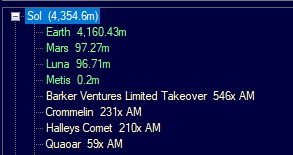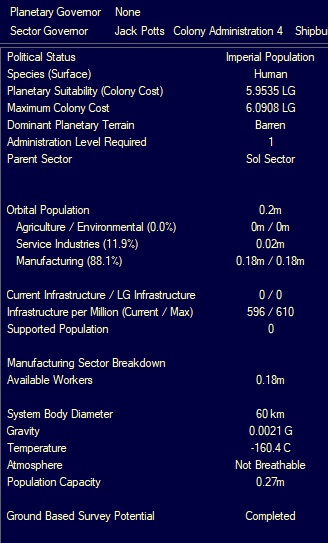Located a few of Steve's posts on Deep Space Populations:
Deep Space Populations
v2.0 introduces a new type of system object known as a Deep Space Population (DSP).
A DSP can be created in the same way as a named waypoint, by clicking the ‘Create Deep Space Population’ button on the Miscellaneous tab of the Tactical Map, selecting a location on the map and choosing a name. A new population will be created at that location and it will be displayed on the map as a yellow dot with the associated population name. The DSP will appear in the Economics window like any other population, except for the suffix (DSP)
The DSP will function as a normal population with the following exceptions:
- There is no associated system body, which means:
- There is no line on the System View window and no mention in any summary of system bodies.
- It will not act as a destination for survey orders.
- There will be no mineral deposits.
- There will be no surface location to place installations, ground forces, fuel, ordnance or MSP.
- Due to the lack of a physical location, no ground combat can take place at a DSP, although any ships or stations at the location can be attacked via boarding combat.
- Minerals can be delivered to the DSP and collected from it, as it assumed these are stored as free-floating resources. They will be displayed as per a normal population.
- For the purposes of population display, the DSP has a colony cost of ‘Not Habitable’ and there are no physical characteristics such as gravity, atmosphere, etc.. It cannot be terraformed.
- Any population for DSP will have to be provided in Ark Modules (see next post)
- The DSP will act as a location for shore leave, if a sufficient population is available.
- Maintenance modules at the DSP will provide a maintenance capacity and allow overhauls, although MSP will have to be drawn from supply ships or supply bases at the location.
- Shipyards can operate at the DSP, as they are orbital, but they will require population based in Ark Modules.
- Repair Bays can operate without population.
- Due to the restrictions, the movement orders that can use the DSP as a destination are more limited than for a planetary population. In general, they will be the same orders available for waypoints, plus mineral-related load and unload orders.
- Orders that have a destination of a fleet in orbit of a DSP will function normally.
- The default order when double-clicking on a DSP is 'Move To'.
- Deep Space Populations do not orbit any stars, with one exception (see next bullet). They remain in their original position.
- When creating a Deep Space Population, if you click on a gas giant or superjovian instead of empty space, the DSP will be created in orbit of the gas giant and will move with the planet. In this case, fleet movement orders will have both the DSP and the gas giant as separate destinations, with one suffixed by (DSP) and the other by (Planet).
- Deep Space Populations have EM and Thermal signatures with the same rules as normal populations.
- A governor can be selected as normal, or set for automated assignment.
- Deleting a DSP on the Economics window will remove it from the Tactical Map.
- DSP cannot be made independent.
- Buttons for instantly adding ground units or installations will not be visible, even in SM mode.
- The Environment tab will be blank
- DSP will appear on the 'All Bodies' tab of the Tactical Map as the first item(s) on the list. Clicking on them will centre the Tactical Map on the DSP.
Population Changes and Ark Modules
Based on discussion on the forums, I've decided to change the way that colonies distinguish between surface and orbital populations. Currently, orbital habitat modules function as a form of infrastructure. If you add one to a population, it creates extra room for the population to grow into. However, if you remove the habitat, the entire population remains on the planet. This is because the population is associated with the planet, not the habitat.
For v2.0, Orbital Habitat modules are being renamed as Ark Modules. They will be able to transport colonists in the same way as cryogenic modules, although they are far larger because the colonists are not frozen in cryogenic chambers. The Cryogenic Transport category on the Class window has been renamed Colonist Transport and the Ark Module will appear in this category once developed. Ships will have distinct Cryogenic Transport and Colonist Transport capacities, with the latter reflecting the Ark Module capacity. A ship can have both cryogenic and Ark modules, but only the latter will contribute to a colony while the colonists are still on board.
When a ship or station with an Ark Module is in orbit of a colony, any colonists in the Ark Module will be considered as 'orbital population' for that colony. The colonists on the surface will be 'surface population'. The two populations are distinct and growth on the surface will not affect the colonists on board the Ark Modules. In effect, the Ark Modules are acting in a similar way to maintenance modules or terraform modules, in that they are 'lending' their capabilities to the colony. In this case, the colony gains extra population. If the ship or station with the Ark modules leaves orbit, it will take its colonists with it.
This new function also allows huge Ark ships that can transport populations through space and then hold position at temporary DSPs to conduct ship-building, etc., without the need for a suitable habitable world that would be required in the case of cryogenic transport.
Any ship loading or unloading colonists will interact only with the surface population, although the ship with Ark Modules could load colonists that a different ship has just unloaded. Depending on playtest, I may also add load/unload colonist orders that have an Ark ship as a target, although I suspect this would be seldom used in practice. Ark Modules will more likely load colonists once and then retain them indefinitely (with the exception being an orbital colony that builds its own Ark ships).
As the population in Ark modules is awake and functional, there will be some population growth if there is space capacity. This growth will be at an annual rate of 5% x (Space Available / Total Capacity). For example, if an Ark Ship is only carrying 75% of capacity, the annual pop growth will be 1.25%. Available space is likely to be a rare situation, but it could happen after damage and repair, or if an Ark loads a surface population less than its capacity.
Ark Modules have built-in life support and do not need any agricultural/environmental population (as is the case now with orbital habitats). Therefore, the orbital population does not have to be the same species as the surface population and multiple different species can contribute from orbit.
In most cases, colonies will function in a very similar way to now. However, the distinct division between surface and orbital populations does result in some changes:
- The infrastructure requirement for a colony, and any associated unrest for overcrowding, only considers the surface population.
- Only the surface population is considered for PPV requirements and any associated unrest.
- Even though only the surface population generates unrest for the above reasons, any resulting impact on political stability affects the whole colony.
- If a colony is conquered, the population in the Ark Modules will not be affected, unless the Ark itself surrenders. The Ark will be unassigned from the conquered colony. The same is true for colony transfers
- Both orbital and surface population generate trade and an orbital-only colony, including a DSP, will produce trade goods.
- Both pops are considered for EM/Thermal signatures and for the 1m requirement for ancient constructs
- Standing orders for civilian colony ships will only consider the surface population.
- Shipping Lines require two surface populations to begin producing ships.
- Editing the population amount in SM mode only affects the surface population






